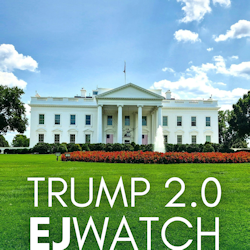SEJournal Online is the digital news magazine of the Society of Environmental Journalists. Learn more about SEJournal Online, including submission, subscription and advertising information.
 |
 |
| A three-decade-old federal rule requiring dangerous U.S. facilities to submit plans for managing disaster may be eliminated under the Trump administration. Above, a combat medic during an exercise simulating a chemical attack. Photo: U.S. Army/Sgt. Jesse Pilgrim via Flickr Creative Commons (Public domain). |
TipSheet: Hazardous Risk Reporting Resource at Risk of Trump Blackout
By Joseph A. Davis
 |
Is there a chemical disaster waiting to happen near you?
Environmental journalists can actually save lives by letting people know about local hazards from toxic, explosive, flammable and corrosive chemicals.
Especially if the federal government doesn't want people to know.
There is a searchable public database of those high-risk sites online right now, where you can look up sites near you.
But the chemical industry wants to black it out.
Saving a key information stream
EDGI is scurrying to rescue it. That’s the Environmental Data and Governance Initiative — a group of volunteers, researchers and former government employees who think the at-risk communities have a right to know.
Kudos to Hiroko Tabuchi, who wrote about it in a New York Times piece March 6. SEJournal has written about the issue often over the years (see our “Editor's Note” below).
Today, the federal government barely regulates hazardous chemical risks — if at all.
After the Bhopal, India, chemical disaster killed thousands in 1984, the industry avoided real regulation by agreeing to disclose its risky activities under the Emergency Planning and Community Right-to-Know Act, better known as EPCRA, in 1986. They have been reneging on that deal ever since.
The Risk Management Program
requires dangerous facilities
to submit a plan for
managing disaster.
One information stream is called the Risk Management Program, a rule from 1996 that requires dangerous facilities to submit a plan for managing disaster.
The RMP has been revised since then, including by Donald Trump’s Environmental Protection Agency during his first term. Former President Joe Biden revised it as well in 2024, and opened the RMP Public Data Tool.
That’s the searchable database the Trump 2.0 wants to torpedo. They haven’t done it yet, but they signaled intent to do so in a court filing.
Currently, EDGI and its partners are working on a searchable replacement for when Trump’s EPA takes the current one down. A working version of the intended replacement is here.
What journalists can do
Journalists can and should make sure their local communities know about the dangers they face. That’s job No. 1.
They can use the RMP Public Data Tool to find out what the facilities are that may affect their communities. And then report.
Fortunately, there are other
sources of data from the
EPA and state agencies.
RMP facilities are important because they are the worst of the worst. Fortunately, there are other sources of data from the EPA and state agencies. For example, the Toxics Release Inventory lists a wide range of problem sites, many less toxic than RMP sites.
There are others, such as the EJScreen tool, which brings environmental justice into the picture by overlaying it with demographics. (EDGI and allies have already saved it.) Or journalists can look to ProPublica’s master data journalism project, “Sacrifice Zones.”
Once you find the hazardous sites near you, take a close look at the demographics of the area. Are there daycares, schools, nursing homes or residences nearby?
Remember, as we like to say, data is just the beginning. Talk to people and visit the site. Groundtruth everything.
[Editor’s Note: For more on this topic, see a recent Feature on chemical plants, terrorism and regulations, a WatchDog Opinion column on risk management plans, plus Backgrounders on the workings of the Chemical Safety Board and the need for ongoing coverage of chemical safety. We’ve also got Toolboxes to help you use the CompTox chemicals dashboard, CAMEO software for covering chemical disasters, Toxic Substances Control Act and hazardous site datasets, as well as TipSheets on tracking down chemical facilities and secret rail hazmat routes near you, and on using toxic chemicals data for reporting in your community. Also see our Feature on how journalistic teamwork uncovered years of chemical regulatory failure in Texas and more in our Topic on the Beat: Disasters page. Plus track headlines on chemicals and on disasters with EJToday.]
Joseph A. Davis is a freelance writer/editor in Washington, D.C. who has been writing about the environment since 1976. He writes SEJournal Online's TipSheet, Reporter's Toolbox and Issue Backgrounder, and curates SEJ's weekday news headlines service EJToday and @EJTodayNews. Davis also directs SEJ's Freedom of Information Project and writes the WatchDog opinion column.
* From the weekly news magazine SEJournal Online, Vol. 10, No. 12. Content from each new issue of SEJournal Online is available to the public via the SEJournal Online main page. Subscribe to the e-newsletter here. And see past issues of the SEJournal archived here.













 Advertisement
Advertisement 



